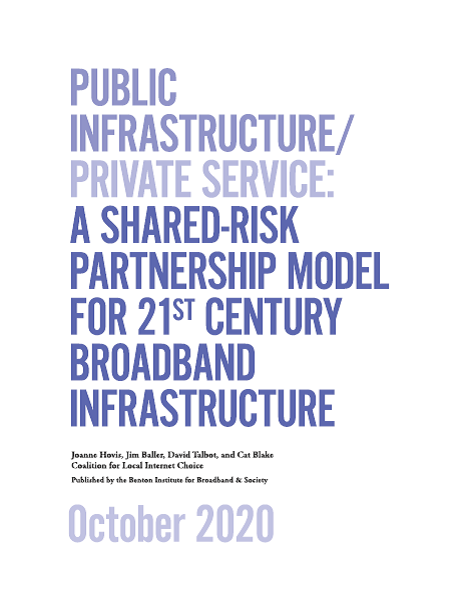Cat Blake

Public Infrastructure/Private Service Model For 21st Century Broadband Proves Worthy
The emerging model presents a scalable option for communities that lack the expertise or interest to operate networks or act as ISPs themselves but want to own and control the core communications assets in their communities as a means of securing the benefits of broadband internet. Here’s a look at the model’s business case, technical elements and risks.
Public Infrastructure/Private Service: A Shared-Risk Partnership Model for 21st Century Broadband Infrastructure
The Public Infrastructure/Private Service model puts the locality in the business of building infrastructure, a business cities and counties know well after a century of building roads, bridges, and utilities. The model leaves to the private sector most aspects of network operations, equipment provisioning, and service delivery. The Public Infrastructure/Private Service model leverages the best capabilities of the public and private sectors.
Private-sector investment alone is not closing our digital gaps. The Public Infrastructure/Private Service model offers a promising solution that is precisely targeted to the areas with greatest broadband gaps, frequently those with lower income levels and lower population densities.


How Can America’s Communities Secure the Benefits of Fiber-Optic Infrastructure?
How can America’s communities secure the benefits of fiber-optic infrastructure? Our answer is that local governments need not accept a binary option of waiting for the private sector to solve the problem—which the private sector already would have done if it made business sense—or taking on the challenge entirely as a public enterprise. Rather, public-private collaboration can disrupt this binary and give communities options.
Next Century Cities’ 2020 Census Kiosk Toolkit
How will 2020 – the first online census – offer new challenges? Historically, the census has always been completed using paper forms. But in 2020, the census will be conducted primarily online for the first time. While there will still be options to respond with a paper form or via phone, most homes will receive an invitation to complete the census online.

Investment in Broadband Infrastructure Can Create Cost Savings and Community Self-Empowerment
Building new broadband infrastructure is a big investment for any municipality. While the cost of that investment shouldn’t be overlooked, it’s equally important to consider the significant cost savings that can be reaped with publicly owned infrastructure. Many cities have slashed the cost of connecting their schools to broadband by opting to build their own infrastructure, instead of continuing to pay a private provider for connections. Portland (OR), for example, had been paying an incumbent provider $1,310 per month for 10 Mbps connections to schools.
Becoming Broadband Ready Means Community Innovation and Collaboration
Next Century Cities teamed up with the Internet Society and Neighborly to create the Becoming Broadband Ready toolkit. This comprehensive toolkit provides local leaders with a roadmap to encourage broadband investment in their community. While every community will choose to tackle connectivity a little differently – a small island community and a large urban center will likely have unique considerations and approaches – there are many common threads that run through successful broadband projects.

The FCC is tasked with solving the digital divide and it's making things worse
In an era that’s buzzing with talk of autonomous vehicles and virtual wallets, mere access to broadband internet remains out of reach for many. And while Federal Communications Commission Chairman Ajit Pai frequently reminds the public that his top priority is closing the digital divide, his actions have made it harder, again and again, for Americans to get internet access. He has been leading the charge to gut Lifeline, the federal program that subsidizes phone and broadband connections for low-income people in the United States.

